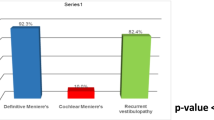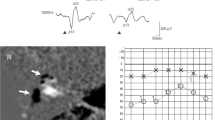Abstract
Previous studies assumed that specific audiometric measures like low-frequency biasing were noninvasive and inexpensive techniques for diagnosing endolymphatic hydrops (EH). The aim of this study was to compare the results of low-frequency DPOAE (LF-DPOAE) with those of transtympanic electrocochleography (ECoG) in patients with Menière’s disease (MD). The prospective study included 50 patients, 22 to 72 years old, who were diagnosed with Menière’s disease according to the criteria laid down by the American Academy of Otolaryngology—Head and Neck Surgery (AAO-HNS) in 1995. LF-DPOAE and ECoG were performed on the same day after standard audiometry. Enlarged amplitude of summation potential to action potential ratio was used as the diagnostic criterion for EH. The results were compared to those of LF-DPOAE. In this audiometric examination we used the modulation index (MI) to detect EH if MI < 0.5. ECoG yielded a result in 46 of the 50 patients examined. An enlarged SP/AP ratio was found in 23 patients (50%). The results of 33 patients could be compared, i.e. assessable results in both tests. The two tests yielded the same results in 13 patients and different ones in 20 patients. ROC analysis and Mann–Whitney statistics showed no significant correlation between the two tests. With ECoG as the gold standard for verifying EH, we found that LF-DPOAE is not yet a suitable method for diagnosing EH.




Similar content being viewed by others
References
Anft D, Jamali Y, Scholz G et al (2001) Electrocochleography and phase audiometry in diagnosis of Meniere disease. Hno 49:102–108
Mrowinski D, Scholz G, Krompass S et al (1996) Diagnosis of endolymphatic hydrops by low-frequency masking. Audiol Neurootol 1:125–134
Hirschfelder A, Gossow-Muller-Hohenstein E, Hensel J et al (2005) Diagnosis of endolymphatic hydrops using low frequency modulated distortion product otoacoustic emissions. Hno 53:612–617
Conlon BJ, Gibson WP (2000) Electrocochleography in the diagnosis of Meniere’s disease. Acta Otolaryngol 120:480–483
Ge X, Shea JJ Jr (2002) Transtympanic electrocochleography: a 10-year experience. Otol Neurotol 23:799–805
Kim HH, Kumar A, Battista RA et al (2005) Electrocochleography in patients with Meniere’s disease. Am J Otolaryngol 26:128–131
Deatherage BH, Henderson D (1967) Auditory sensitization. J Acoust Soc Am 42:438–440
Zwicker E, Leysieffer H, Dinter K (1986) An implant for stimulation of the acoustic nerve with 12 channels. Laryngol Rhinol Otol (Stuttg) 65:109–113
Frank G, Kossl M (1997) Acoustical and electrical biasing of the cochlea partition. Effects on the acoustic two tone distortions f2-f1 and 2f1-f2. Hear Res 113:57–68
Bian L (2004) Cochlear compression: effects of low-frequency biasing on quadratic distortion product otoacoustic emission. J Acoust Soc Am 116:3559–3571
Scholz G, Hirschfelder A, Marquardt T et al (1999) Low-frequency modulation of the 2f1-f2 distortion product otoacoustic emissions in the human ear. Hear Res 130:189–196
Scholz G, Mrowinski D, Hensel J (1999) Phase-dependent suppression of transient evoked and distortion product otoacoustic emissions by a low-frequency tone. Audiology 38:271–275
Kummer P, Janssen T, Arnold W (1995) Suppression tuning characteristics of the 2 f1-f2 distortion-product otoacoustic emission in humans. J Acoust Soc Am 98:197–210
Krueger WW, Wagner AP (1997) Needle placement with transtympanic electrocochleography. Laryngoscope 107:1671–1673
Wuyts FL, Van de Heyning PH, Van Spaendonck MP et al (1997) A review of electrocochleography: instrumentation settings and meta-analysis of criteria for diagnosis of endolymphatic hydrops. Acta Otolaryngol Suppl 526:14–20
Fetterman BL (2001) Distortion-product otoacoustic emissions and cochlear microphonics: relationships in patients with and without endolymphatic hydrops. Laryngoscope 111:946–954
Chung WH, Cho DY, Choi JY et al (2004) Clinical usefulness of extratympanic electrocochleography in the diagnosis of Meniere’s disease. Otol Neurotol 25:144–149
Ghosh S, Gupta AK, Mann SS (2002) Can electrocochleography in Meniere’s disease be noninvasive? J Otolaryngol 31:371–375
Ruth RA, Lambert PR (1989) Comparison of tympanic membrane to promontory electrode recordings of electrocochleographic responses in patients with Meniere’s disease. Otolaryngol Head Neck Surg 100:546–552
Levine SC, Margolis RH, Fournier EM et al (1992) Tympanic electrocochleography for evaluation of endolymphatic hydrops. Laryngoscope 102:614–622
Maier W, Aschendorff A, Arapakis I et al (2004) Electrophysiologic examinations in low frequency hearing impairment: clinical and prognostic aspects. Laryngorhinootologie 83:824–830
Noguchi Y, Nishida H, Tokano H et al (2004) Comparison of acute low-tone sensorineural hearing loss versus Meniere’s disease by electrocochleography. Ann Otol Rhinol Laryngol 113:194–199
Sass K (1998) Sensitivity and specificity of transtympanic electrocochleography in Meniere’s disease. Acta Otolaryngol 118:150–156
Devaiah AK, Dawson KL, Ferraro JA et al (2003) Utility of area curve ratio electrocochleography in early Meniere disease. Arch Otolaryngol Head Neck Surg 129:547–551
Shojaku H, Takemori S, Kobayashi K et al (2001) Clinical usefulness of glycerol vestibular-evoked myogenic potentials: preliminary report. Acta Otolaryngol Suppl 545:65–68
Kimura H, Aso S, Watanabe Y (2003) Prediction of progression from atypical to definite Meniere’s disease using electrocochleography and glycerol and furosemide tests. Acta Otolaryngol 123:388–395
Seo T, Node M, Yukimasa A et al (2003) Furosemide loading vestibular evoked myogenic potential for unilateral Meniere’s disease. Otol Neurotol 24:283–288
Magliulo G, Cianfrone G, Gagliardi M et al (2004) Vestibular evoked myogenic potentials and distortion-product otoacoustic emissions combined with glycerol testing in endolymphatic hydrops: their value in early diagnosis. Ann Otol Rhinol Laryngol 113:1000–1005
Author information
Authors and Affiliations
Corresponding author
Rights and permissions
About this article
Cite this article
Rotter, A., Weikert, S., Hensel, J. et al. Low-frequency distortion product otoacoustic emission test compared to ECoG in diagnosing endolymphatic hydrops. Eur Arch Otorhinolaryngol 265, 643–649 (2008). https://doi.org/10.1007/s00405-007-0520-9
Received:
Accepted:
Published:
Issue Date:
DOI: https://doi.org/10.1007/s00405-007-0520-9




